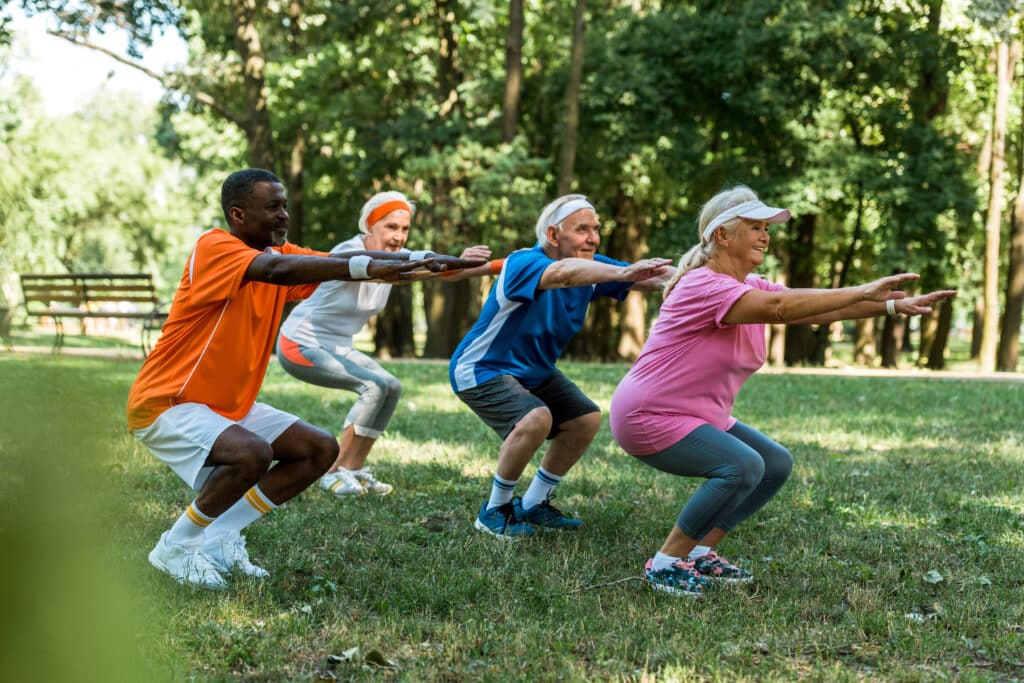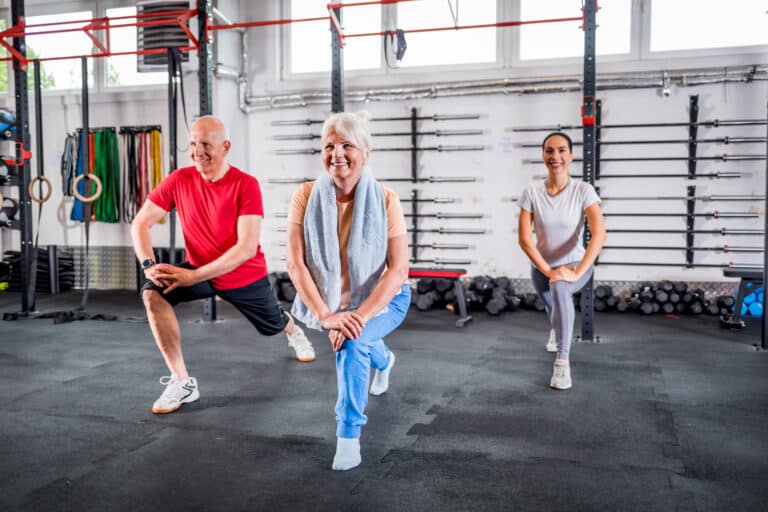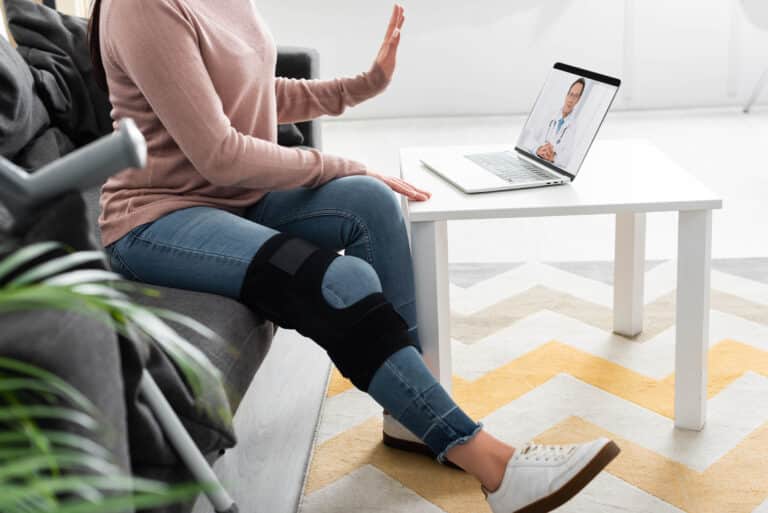Knee pain when squatting can be a frustrating barrier to maintaining an active lifestyle. If you’re living with knee pain that’s limiting your ability to bend and squat, don’t throw in the towel just yet!
This type of pain can usually be treated with effective pain management, changes to certain activities, corrections to your squat technique, and guided exercise from a trained physical therapist.
As a physical therapist with plenty of experience helping older adults recover, I hope to provide valuable insight to simplify this seemingly complex problem. This article will provide practical, evidence-based advice to improve knee pain and improve function.
But why do your knees hurt in the first place? To understand squatting knee pain, we need to first dig into potential causes and the anatomy and function of the knee joint.
Common Causes of Knee Pain During Exercise
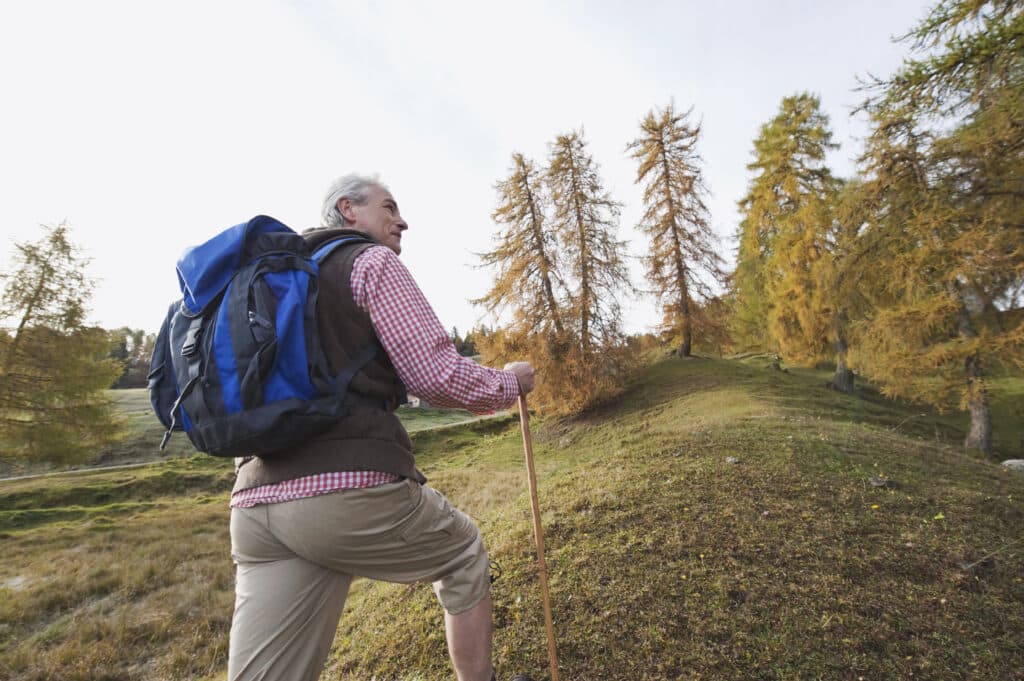
Here’s the anatomy of your knee in a nutshell:
The knee joint is a complex structure where the thigh bone (femur), shin bone (tibia), and kneecap (patella) meet. It’s cushioned by two cartilage discs called menisci and stabilized by ligaments and tendons, enabling us to perform movements like walking, running, and squatting.
When your knee joint experiences pain during an activity like squatting, it could be due to various reasons depending on your activity and lifestyle. Like many injuries, no single cause is always the culprit.
However, four sources arise most frequently, often leading to pain and movement limitation: osteoarthritis, patellofemoral pain syndrome, tendinitis, and meniscus injuries.
Osteoarthritis
Osteoarthritis is a degenerative joint disease that leads to the breakdown and eventual loss of cartilage, the tissue responsible for cushioning the ends of the bones within the knee joint. This degeneration results in inflammation, causing pain, stiffness, and a reduced range of motion.
In the United States alone, about 32.5 million adults are living with osteoarthritis, according to the Centers for Disease Control and Prevention.1
It’s a significant contributor to chronic pain and disability, particularly among older adults, and the knee joint is one of the most common joints affected.
Patellofemoral Pain Syndrome
If you’re feeling pain at the front of your knee or around the kneecap, particularly when squatting, running, or climbing stairs, you might be experiencing patellofemoral pain syndrome.
This condition occurs when the kneecap is improperly aligned, leading to repetitive stress in certain areas of your knee.
Most often, with patellofemoral pain syndrome, the pain you feel results from your kneecap rubbing against the lower part of your thigh bone instead of gliding smoothly over it, leading to discomfort.
This condition is quite common and can often be managed with appropriate care.2
Knee Tendinitis
Tendinitis happens when the tendons – the thick cords attaching your muscles to your bones – become inflamed or irritated.
This condition is often felt as a dull, aching sensation around the front and deep inside the knee, especially when walking, climbing stairs, or standing for a long time.
Knee tendinitis is often associated with repetitive stress on the knee joint. It can result from activities like running or jumping, which tend to impart a lot of stress on knee tissues.
Over time, this constant strain can lead to irritation of tendons, causing pain and some swelling.
It’s a common ailment but also highly treatable. Most patients I see with knee pain while squatting deal with tendinitis, most commonly tendonitis of the patellar tendon in the front of the knee.
It’s also important to know that tendonitis can sometimes happen due to compensations related to another condition, such as patellofemoral pain syndrome.
Meniscus Injuries
The menisci are cartilage discs acting as shock absorbers between your thigh and shin bones. Although common in sports that involve sudden twisting or bending of the knee, meniscus injuries can also occur from repetitive wear with age.
Symptoms of a meniscus tear might include locking or clicking in your knee and can cause you to become stuck while bending your knee during squatting and kneeling.
A study in the Journal of the American Academy of Orthopaedic Surgeons noted that meniscus tears are frequent in the aging population, often resulting from degenerative changes rather than sports injuries.3
Remember, it’s always essential to consult with a healthcare professional if you’re experiencing knee pain or any other health concerns. With the help of someone like a physical therapist, you can get a proper diagnosis and treatment plan tailored to your specific needs.
Preventing and Managing Knee Pain When Squatting
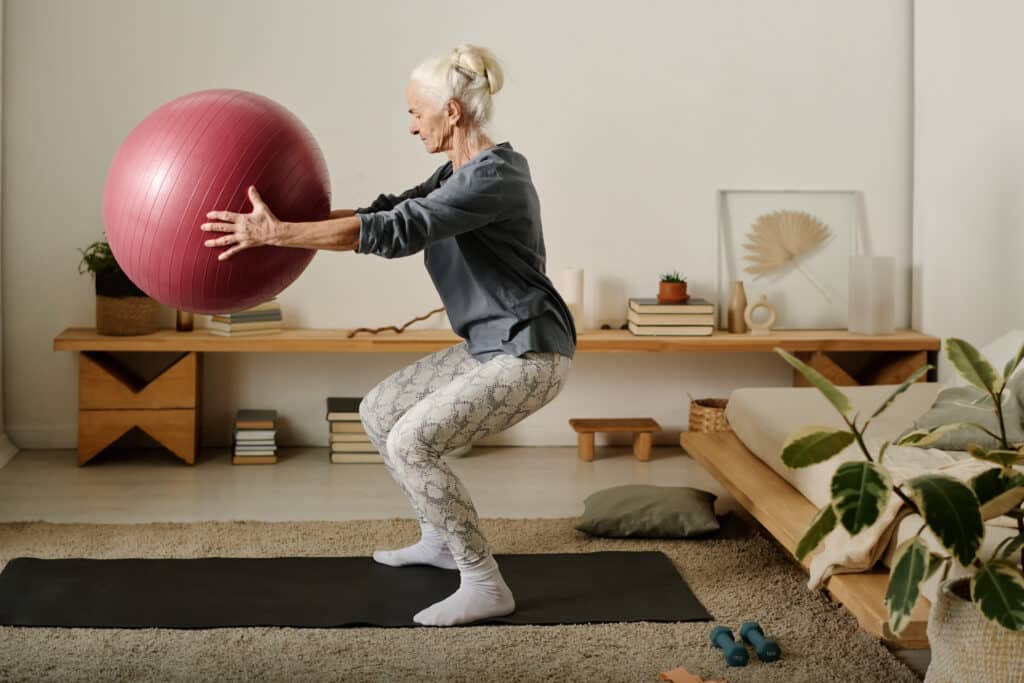
As we age, our bodies can start sending signals that certain activities aren’t as easy as they used to be. Pain when squatting is often one of these important signals.
Untreated knee pain can often lead to complications. On the other hand, quickly addressing knee pain can help you stay active and improve your overall quality of life. Here are some of the most important things to consider to prevent knee pain before it becomes a bigger issue.
The Basics of Knee Pain Prevention
There are a few key strategies to remember when it comes to preventing and managing knee pain when squatting.
These include modifying or avoiding activities that cause pain and incorporating alternative exercises that are gentler on the joints.
Modified Exercises for Knee Pain
You don’t have to stop exercising altogether if squats cause knee pain. Many alternative exercises can still give you a great workout without putting too much strain on your knees.
Partial squats are a great option, as they reduce the degree of knee bend and stress on your knee joints. This simply means limiting the depth of your squat to avoid the irritable range of motion. Tip: Rather than using a chair or a bench as a “target” for your squat, try using a taller stool or a surface around waist level versus knee level.
Here are a couple of other exercises that you might consider trying if squats are painful:
Sit-to-Stand
Sit-to-stands also allow you to feel confident getting lower into a squat if you need to sit down suddenly due to pain or fatigue. In this case, you would sit all the way down in the chair, providing a supportive resting point before standing back up again.
Step Ups
Step-ups are another great alternative, offering lower body benefits similar to squats while being friendlier to your knees.4
- When doing a step-up, simply place one foot on a stair or a slightly higher surface, bring the other foot up to meet it, then carefully step down again.
- If you’re just starting with step-ups, use a low step first. Once you’re more comfortable, increase the height of the step to add more challenge.
- If you experience pain while doing these exercise alternatives, it’s best to consult your physical therapist to find the best exercises for you.
In my experience working with older adults who have knee pain while squatting, most of these exercises are used as temporary alternatives during recovery from an injury. However, they are still great long-term options if you’re living with a condition that consistently causes knee pain while squatting.
Squatting Safely: Tips and Tricks
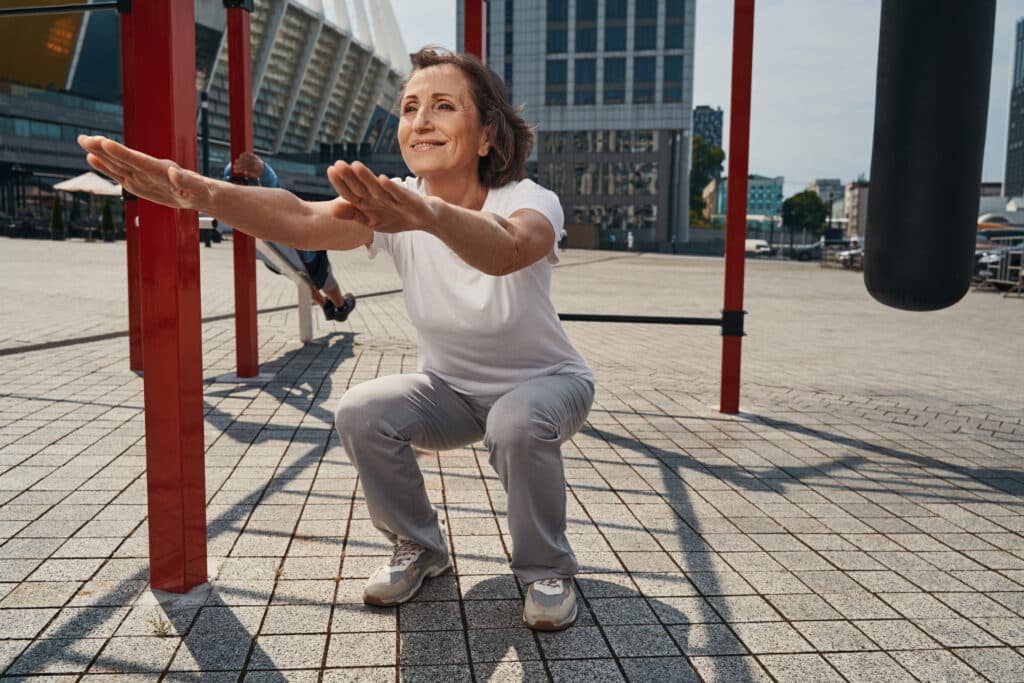
Safe technique is vital to prevent injuries and ensure the most significant benefits from our workout. After all, it’s about what exercises we do and how we do them.
There are a few helpful strategies to perform them with less stress on your knee if you want to keep squats in your movement repertoire.
Here are some of the tips that I most often give to my patients:
Keep Your Knees Aligned with Your Toes
When your knees and toes are aligned, you can reduce the strain on your knee joints. When squatting, ensure your knees and toes are pointed in the same direction, avoiding positions like caving in or bowing out. This is a common movement error that can often be corrected with some simple awareness of the position of your knees.
Keep Your Heels on The Ground
When squatting, ensure your heels don’t shift up from the floor, as this can move most of your body weight into the front of your knees. Keeping your heels on the ground helps distribute the workload evenly across your lower body.
This transition of your body weight forward can put more pressure on your knee joints, and can irritate tissues for some people. Instead, simply try to keep your heels and your toes firmly anchored to the floor throughout.
Avoid Excessive Depth or Speed
Squatting too low or too quickly can increase the chances of knee pain while squatting. Aim for a 90-degree bend in your knees and control your speed as you lower your body. Giving your joints time to adapt to the movement can help to avoid knee pain before it starts. It also gives you an opportunity to correct your form using the other cues above.
Preventing knee pain when squatting is anything but black and white, and focusing on the most comfortable squatting technique for you matters most.
You might not look like a model example of squat technique when you squat down, and that’s perfectly okay. However, by following these guidelines and listening to your body, you can have a better chance of continuing to enjoy the benefits of exercise while minimizing the risk of injury.
Physical Therapy: An Effective Solution for Knee Pain
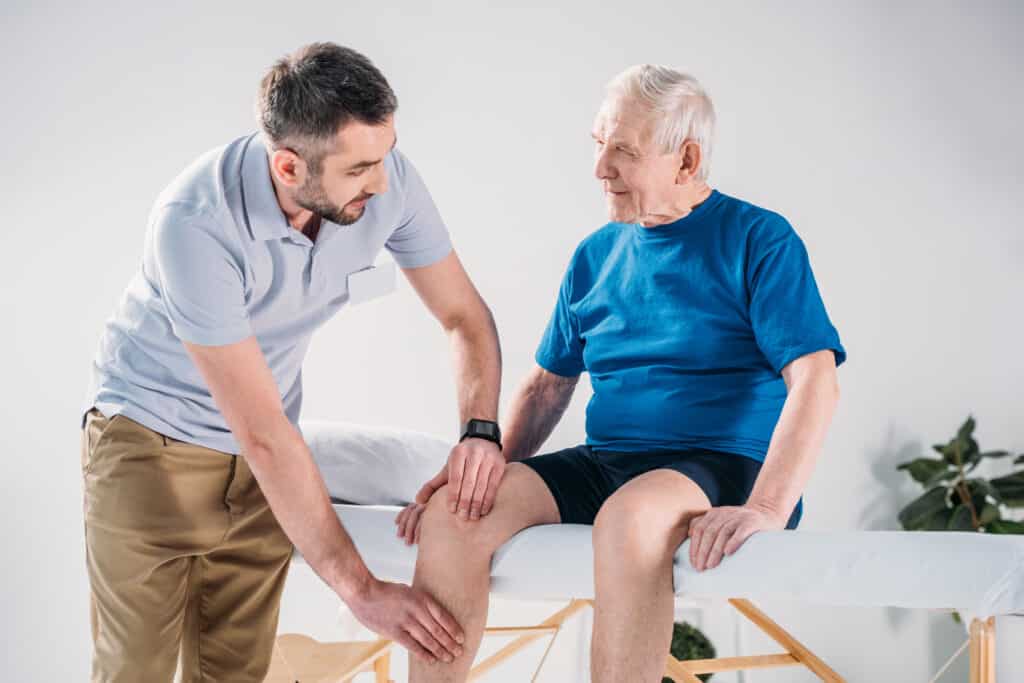
In many cases, knee pain when squatting can be alleviated through physical therapy. As a non-invasive approach that aims to strengthen the muscles around your knee, enhance flexibility, and improve the function of your knee joint, physical therapy is an excellent option for older adults who want to improve their knee health.
Your physical therapist can teach you several physical therapy exercises and techniques specifically designed to treat knee pain. These might include:
- Targeted stretching to increase flexibility of your hip, knee, and ankle.
- Strengthening exercises to fortify the muscles of your leg.
- Mobilization techniques to improve the function of your knee joint.
When selecting a physical therapist, look for someone specializing in orthopedic or geriatric physical therapy training.
They’ll assess your unique situation at your first appointment and devise a personalized treatment plan. It’s a collaborative process, so don’t hesitate to ask questions or share concerns.
Braces and Orthotics: Supporting Your Knees
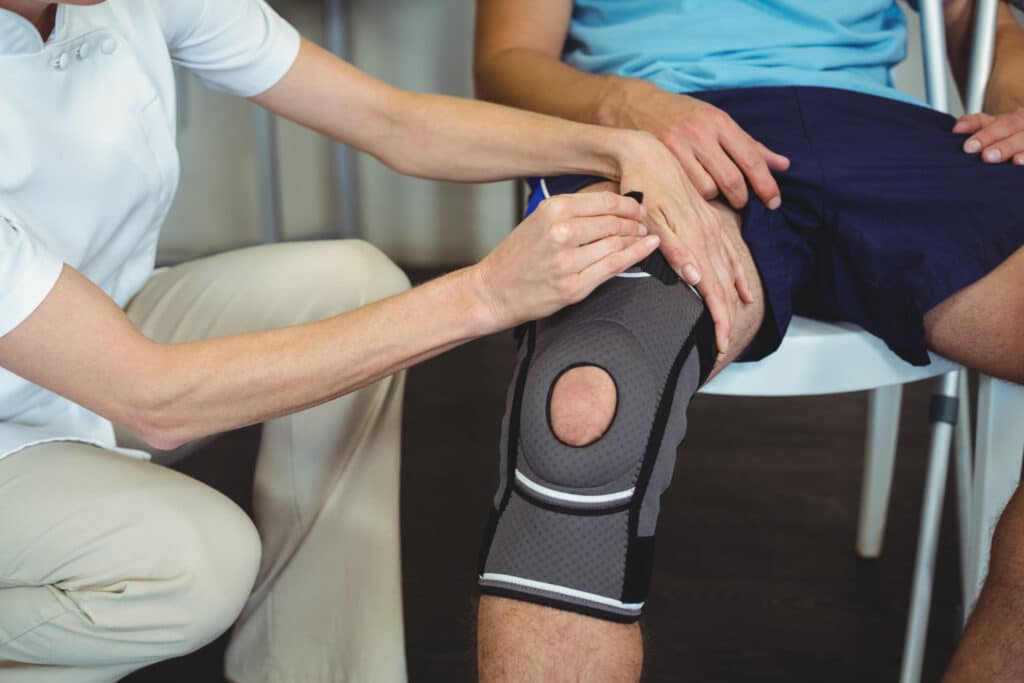
Using braces or orthotics is another effective strategy for managing knee pain when squatting. These devices provide extra support and stability to your knee joint and can help promote better alignment – think of them as added guidance for your knee, helping you move more comfortably.
When you’re dealing with knee pain when squatting, a brace that fits your knee properly can help redistribute stress on your knee or help reduce unwanted motion.
While many different braces are available, the best one for you will depend on the cause of your knee pain and should be chosen with the help of your doctor or physical therapist.
NEENCA Compression Knee Sleeve
If you have a nagging knee pain that you want to protect from getting worse, you may benefit from wearing a compression brace with lateral support. This type of brace can reduce inflammation, improve blood flow, and provide some stability for your knee. Just remember this is a “comfort fix”, not a long-term solution. You’ll still want to follow up with your physical therapist for exercises and other therapies that can help you manage your pain and prevent further damage to your knee.
The highly rated Neenca Compression Knee Sleeve is the brace we most often recommend to our patients.
Our recommendations are the same items we trust and prescribe to patients. When you buy through links like this on our site, we may earn an affiliate commission to support new content.
While they don’t directly support your knee, orthotics for your shoes can help reduce knee pain when squatting by supporting your foot. This is because the position of your foot during squatting can change how stress is placed on your knee. Similar to braces, selecting the correct orthotics for your needs is best done with the help of a professional.
Having worked with many older adults to improve knee pain, I’m a big fan of braces and orthotics in the short term.
However, I almost always encourage weaning off equipment over time to prevent dependency or the inability to move comfortably without it. Long term use should be discussed with your doctor or physical therapist.
Ice or Heat to Soothe Achy Knees
Although not a fix for knee pain, applying ice or heat to your knee can help reduce pain and stiffness before or after squatting.
For ice application, aim for 10-20 minute applications after activity, with at least an hour in between sessions for to prevent frostbite. Ice is particularly effective for new pain or flare-ups and can be an excellent way to manage pain and swelling.
Heat, on the other hand, can help relieve pain and stiffness before or after activity. Similar to ice, aim for 10-20 minutes of heat application to get the best results.
While ice and heat can be helpful, they are not a replacement for active solutions to knee pain like exercise. The more you stay active and strengthen your knee with exercises recommended by your physical therapist, the more likely you will get long-lasting results for your knee pain when squatting.
Remember that every person is unique, and what works for one person might not work for another. Always consult your healthcare provider before starting any new treatments for knee pain.
Summary
As a physical therapist specializing in older adult care, I emphasize understanding knee pain causes like osteoarthritis and tendinitis. Proper squatting techniques, such as aligning knees with toes and keeping heels down, are essential for prevention. Physical therapy plays a crucial role with exercises tailored to strengthen and improve flexibility. Alternatives like partial squats and step-ups offer relief without straining the knees. While braces and orthotics can provide temporary support, seeking personalized advice from healthcare professionals is important. Active involvement in prescribed exercises and sensible modifications in daily activities is key to managing knee pain effectively and sustaining a healthy, active lifestyle.
Key Takeaways
- Understanding knee pain causes (osteoarthritis, patellofemoral pain syndrome, tendinitis, meniscus injuries) is crucial for management.
- Proper squatting technique (knee-toe alignment, keeping heels grounded) prevents pain.
- Physical therapy is essential, offering exercises to strengthen and increase knee flexibility.
- Alternative exercises (partial squats, sit-to-stands, step-ups) benefit while minimizing knee strain.
- Braces and orthotics provide temporary support and stability, aiding in pain relief and alignment.
- Preventative strategies include modifying activities and practicing safe exercise techniques.
- Consulting healthcare professionals ensures accurate diagnosis and personalized treatment.
- Non-invasive treatments like ice or heat applications complement active rehabilitation.
- A personalized care approach recognizes individual differences in knee pain experiences.
- Staying informed and actively engaging in exercises promotes lasting improvements and a higher quality of life.
References
- Centers for Disease Control and Prevention, “Osteoarthritis (OA)”
- American Family Physician, “Management of Patellofemoral Pain Syndrome”
- Journal of the American Academy of Orthopaedic Surgeons, “Meniscal Tear in the Aging Population”
- Journal of Orthopaedic & Sports Physical Therapy, “Patellofemoral Joint Forces and Stress During Forward Step-up, Lateral Step-up, and Forward Step-down Exercises”

